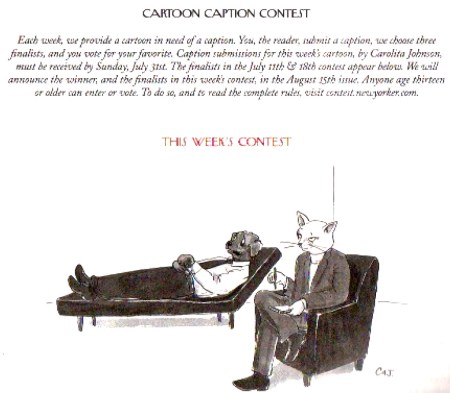The captioning contest in The New Yorker‘s 8/1/22 issue:
(#1) Dog as Patient, Cat as Therapist, both presented very clearly as male — but still I understood it as a gender cartoon, with a penetratingly critical feminist pussy wielding an aggressive masculine persona (think Marlene Dietrich in a tuxedo, but with Susan Sontag’s sharp tongue) against the feckless hound pouring out his smug superiority towards “the little ladies”, as he calls them; I’m perfectly aware that very few other people would see things this way, and I expect the caption entries to be about the conventional natures of cats and dogs
So when I saw Johnson’s captionless Psychiatrist cartoon, I found it bitingly funny just as it stood. And wondered about CAJ.
Oh my.
Let me jump right into the hard stuff. It turns out that CAJ is the creator of this cartoon (very much not a New Yorker thing), in which she inhabits Sweeney Todd:
(#2) Does anyone remember Hothead Paisan: Homicidal Lesbian Terrorist, and her lopping shears? You should check her out, you really should (I recently recommended her to my grandchild; what, after all, are eccentric grandfathers for?)
For the New Yorker, CAJ has somewhat less savage moments, like this one (a daily cartoon from the magazine):
(#3) Ok, I admit to rooting for the spider to drag Mr. Patronizing off to her webby lair, to dissolve his internal organs with her venom and consume them, leaving only his husk — with that smile
I swear that when I saw #1, I knew nothing at all about CAJ. But somehow I intuited her tone. (There are good guys in her women’s world, just are there are good straight men in my queer world — but they’re not the problem, and humor feeds on problems.)
Carolita Johnson (a freelance contributor to The New Yorker since 2002) on LinkedIn:
About: I do cartoons, short graphic narratives, illustrated essays, illustrations, storytelling (live performances with and without images), and I teach (writing with illustrations). I am a feminist killjoy, and have lost interest in promoting the agenda of the Patriarchy or glossy women’s magazines (basically the same thing). But otherwise, I’m a delight! I’m not a prima donna, and I enjoy working with people on their ambitious, funny, socially aware, feminist projects.
You’ll like me, but it has to be on my terms; you have to take me as I am, and here’s how I am.
Men say some version of that all the time; why is it outrageous for a woman to make it explicit for herself?
Performing gender: crossing your legs. One very small piece of the cat therapist’s performance of masculinity is the way they cross their legs, which is a very strong signifier of masculinity in the sociocultural world of the presumed readers of The New Yorker (and of this blog). (The sociocultural meanings of postures and gestures, including the positioning of the legs while sitting in a chair, are, of course, fabulously variable across cultural settings. But #1 is located in a very specific cultural setting.)
That is, this particular posture — figure-four (or ankle-on-knee) — is almost entirely used by men.
(When I was still able to cross my legs, this was my regular way of doing so. I was entirely aware that the posture conveyed masculinity, and that some men smelled a whiff of femininity in knee-on-knee, and the full stink of it in its reserved variant.) Ankle-on-knee is, first of all, genitally comfortable, in a way that knee-on-knee (which risks squeezing the genitals) is not. In addition, it takes up space in the horizontal plane, so that, like manspreading, it asserts a masculine territorial right. Knee-on-knee can be equally territorial, however, when the top foot is extended:
(#5) Knee-on-knee, extended variant (photo from the Quora site); the clothing, hairstyle, and facial expression shout PowerMan, but try to focus on the legs
The reserved variant of knee-on-knee consumes as little horizonal space as possible, so it conveys diffidence, disengagement, modesty, privacy, agreeableness, hesitancy, lack of confidence — or, since it’s a conventionally prescribed sitting posture for “lady-like”, demure women, flat-out femininity (or then, of course, homosexuality). A cute — also smiling and scruffy — young man (pretty much as far as you can get from the male persona in #6) performing this variant:
(#6) Knee-on-knee, reserved variant (photo from the Quora site); this has the left knee on top, so it’s essentially the same as this demure sitting posture for women:
(#7) Knee-on-knee, reserved variant — or with the right knee on top, plus a bit of angling:
(#8) Knee-on-knee, reserved variant; the angling might be seen as conveying indirection, so even more demure than #7
Angling a leg (possibly for indirection) also occurs in the simple closed-legs sitting posture for demure women:
In any case, the cat therapist in #1 not only is clothed as a man (suit and tie, trousers, men’s shoes), they’re also performing ankle-on-knee leg-crossing just as in #4, strongly signifying masculinity (vs. the feminine leg-crossings in #7 and #8, and in some eyes, #6 as well). Yet I sense gender play here. In a while we’ll see what the three finalist captioners do with the image.









Leave a Reply